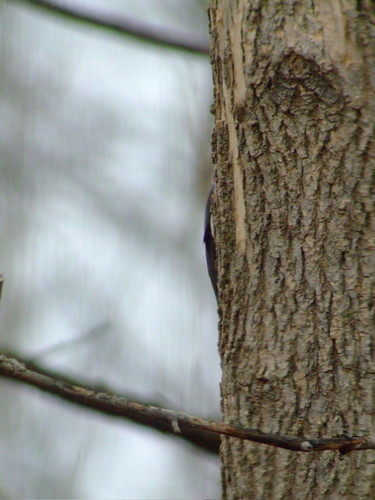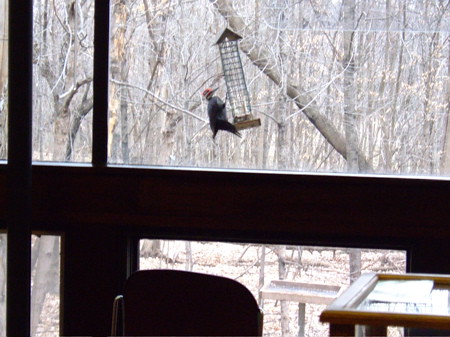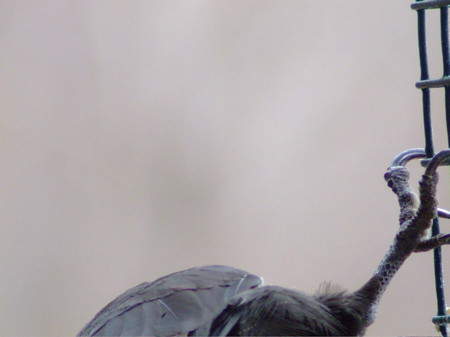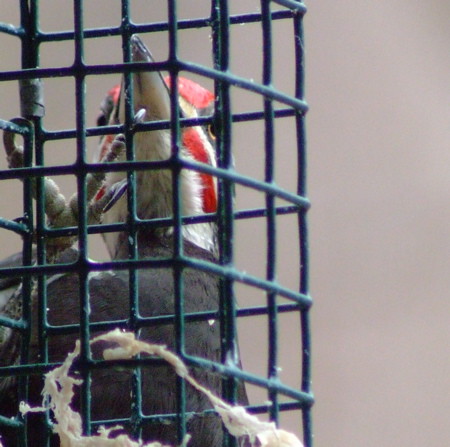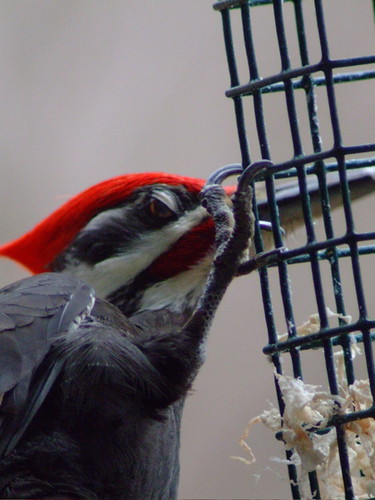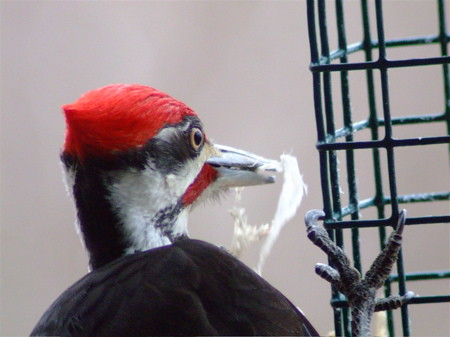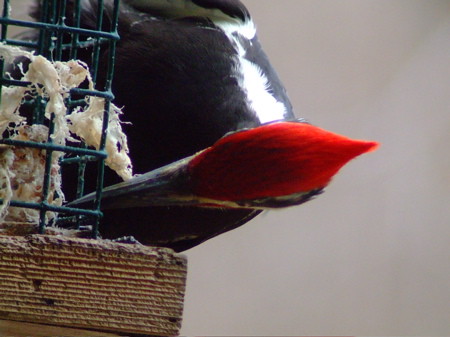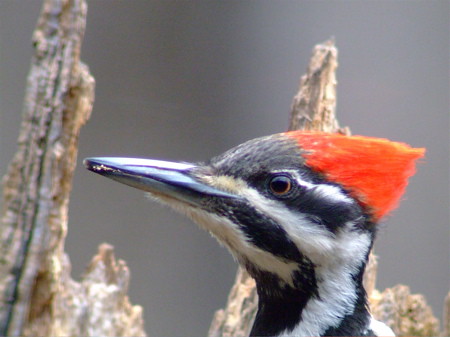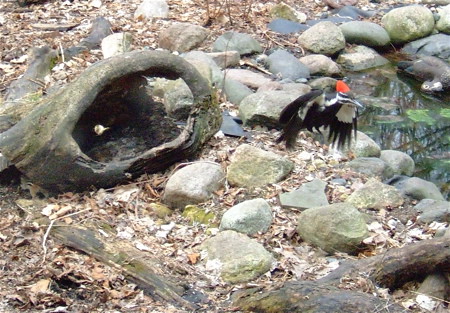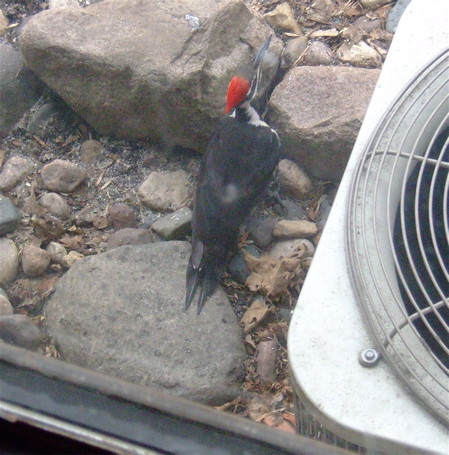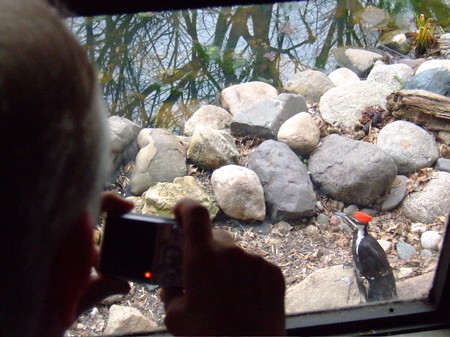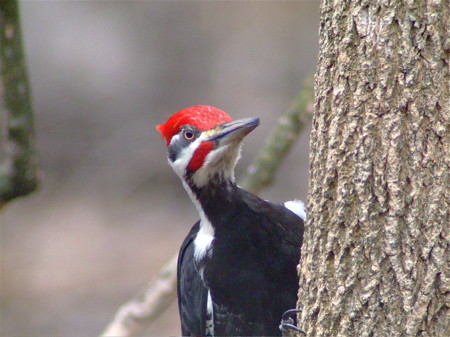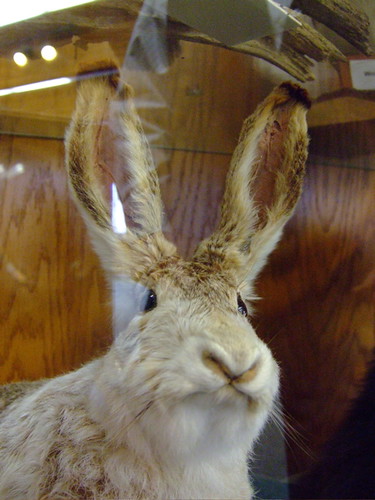Holy crap, this is going to be a super cool post! Warning: Gratuitous photos of pileated woodpeckers ahead.
So, today I had a meeting with the Explore Minnesota Tourism folks at Eastman Nature Center in Elm Creek Park (cool stuff that generated from that meeting will pop up in the next few weeks). During a break in the meeting, I went to check their feeders for some digiscoping. At first I just saw the usual suspects: nuthatches, downy woodpeckers, chickadees, etc. The feeders were spread between two rooms. When I walked into the second room, I saw this:
Okay, it may be hard to get an idea of scale with this tree, but that is a large sliver of a lump up there. I knew instantly: a pileated woodpecker. Knowing how cagey these guys can be, I just set the scope up and started to photograph hoping I might get a shot of the head.
Then, the pileated flew over to the window feeders! I was way too close to digiscope, so I took a photo old school style--just through the point and shoot. I went to the back of the room and tried to digiscope.
However, the feeder was swinging violently due to the bird's weight. It was a tall order trying to get the head in the frame and in focus at the same time. I have about 50 blurry and blank photos.
Okay, there's the head, and it's kind of in focus...but the suet feeder is in the way! Although, I did like this shot because if you look at the bottom of the lower mandible you can see it's white. I have never had the opportunity to see that part of pileated, who knew it was white?
Okay, still not quite in focus but I love this because the woodpecker was in mid peck and had its eyelid lowered to protect its eyes. This looks thicker than a nictitating membrane (extra eyelid birds have that is transparent--they use it to protect pupils in flight so dust won't damage it). I'm sure they have some sort of eyelid protection since they chip off such large chunks of bark when pecking.
Whoot! It's in focus, it's not head on, but you can still see the face very well. I like how you can see the crest feathers come together in the back. Kind of reminds me of a kewpie doll.
I couldn't believe how accommodating this bird was. The whole group had gathered in the room to watch at this point. I asked one of the naturalists if the windows were tinted and she said that they are not, these birds are just that used to people. There was also a female flying around, she was eating at the tray feeder. She tried to bump the male from the feeder, but he always won.
She was fairly close to and I was able to get a head shot of her. For those who can't tell the difference between male and female pileated woodpeckers, here is what you need to look for: the female lacks the red mustache and her red crest starts halfway up her head as opposed to right at the bill. I was pretty jazzed about this photo. Finally, a crisp head shot! Double whoot!!
The female started working her way around towards another empty suet feeder. However, instead of flying up to the empty feeder...
She went right underneath us to forage for all the fallen suet chunks! What a treat to look right down on a pileated woodpecker only five feet away! I was so excited, I almost peed my pants. There were still about ten of us in the room and we call crowded around the window.
Here's my buddy Carrol Henderson taking a photo of her. It's not uncommon to see pileateds on the ground, they do forage a bit, not quite as much as northern flickers, but they do know how to dig around old fallen snags for juicy bugs.
The male didn't stray too far away. When he was finished at the other suet feeder, he flew to a tree to keep an eye on the female. My goodness, were we watching a pileated lunch date? Boy, if things keep going this well, he'll be at third base in no time.
Eventually, the birds flew off and we had to finish the rest of the meeting. Sigh.
The naturalists told us about a barred owl nest right along one of the trails. While we were finishing our meeting, I saw Sue who volunteers with me at The Raptor Center walk by the outside window. I flagged her down to say hi. She was going to look for the nest, so I told her to let me know if she found it on her way back. Five minutes later she walked past the window and gave a thumbs up--she saw the owl. Afterwards we went to look for it, we found the nest hole, but she was hunkered down for the day doing some hard incubating. Now quite what I was hoping for, but after the pileated show how can I really complain?
One last thing, we did find a disapproving jack rabbit at Eastman Nature Center. Apparently, he didn't approve of being stuffed.
 Oh, to be a bunny tucked away in her little cardboard fortress of solitude with nothing more to do but disapprove of my receipt filing system.
Oh, to be a bunny tucked away in her little cardboard fortress of solitude with nothing more to do but disapprove of my receipt filing system.








